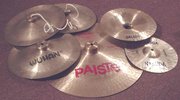China cymbal
|
|
In western music, china type cymbals are cymbals deliberately manufactured to have a "trashy" tone in some ways similar to a chau gong.
China type cymbals typically have a bell that is cylindrical or shaped like a truncated cone with its base the top of the bell, an outer rim that is turned up in the reverse direction to the main bow of the cymbal, little or no taper (change in thickness) from bell to rim, and an area including the inside of the bell that is unpolished. However some china type cymbals have only some or in some cases none of these distinguishing characteristics. The distinguishing feature of a china type cymbal is the one that is hardest to define: Its sound. China cymbals are those whose sounds are derived from the Chinese, rather than the Turkish, tradition of cymbal making.
There are two or three tonal families of cymbals: Turkish, Chinese, and some would say European, although others would include the European family of tones as a development of the Turkish sounds. The best Turkish (and European) cymbals have a rich, swelling tone that some describe as "sweet". To western ears, the best china types have an abrasive, cutting sound that is described by western drummers as "trashy".
Aachinabell.jpg
The families do to some extent overlap. Notably, pang and swish cymbals have some characteristics of china types, and some characteristics of traditional Turkish cymbals. On the other hand, the Sabian roctagon cymbals and some Ufip models are considered china types while having none of the physical characteristics of the normal china type, while the Paiste crystal crash is considered a European cymbal despite its squarish bell.
Cymbal making in China is claimed to predate the development of the art anywhere else in the world. The most universally acclaimed cymbal alloy, bell bronze, appears to have been independently developed in China. Today in China a wide range of cymbals are manufactured of both traditional and imported patterns. Traditional Chinese types with distinctive names and sounds include chung, jing and water cymbals and many other types. In Western music these are all referred to as china type cymbals.
China type cymbals are available in a wide range of sizes from 27" down to 6", most types singly but some in pairs. Those smaller than 12" are normally referred to in Western music as china splash cymbals. When used in a drum kit, they are regarded as effects cymbals and are used to give colour and variety.
In a drum kit, china type cymbals are sometimes mounted bell up, similarly to other cymbals, but more often bell down. When mounted bell down, the upturned rim becomes a downturned rim, allowing a normal stick technique to be used for both ride and crash patterns. This assumes that the bell is formed in the typical direction; Some china type cymbals have an inverted bell and an upturned rim, and so must be mounted bell up to achieve this downwards rim orientation.
If a Turkish pattern cymbal is mounted bell downwards, the rim is exposed to the stick, and there is a considerable risk of splitting the cymbal, but it is notable that if mounted in this way despite the risk (and played gently), many Turkish pattern cymbals will produce a "trashy" tone of sorts. This trashy tone is generally considered much inferior to that of a genuine china type cymbal. On the other hand, many (NB not all) china types can be mounted either way up as desired, as the relatively thick rim is resistant to splitting, giving yet more tonal possibilities.

